“We think we've come so far. Torture of heretics, burning of witches, is all ancient history. Then, before you can blink an eye, suddenly, it threatens to start all over again.” -Captain Picard
It’s been another remarkable week here at Starts With A Bang! Of course there's been news, science, physics and astronomy galore, but the biggest news on my front is that my next book has been officially announced by Star Trek!
You can pre-order it already at Amazon, and we have an official release date: October 15th! There are 28 Star Trek technologies featured inside each with their own chapter, with the up-to-date science status of each of them, plus officially licensed images (over 100!) drawn from all the TV series and movies.
Now, take a look back at this past week's articles:
- Is there a center of the Universe? (for Ask Ethan),
- Faintest galaxies ever seen explain the 'missing link' in the Universe (for Mostly Mute Monday),
- How flat can a planet be?,
- Firing a gun into the air can kill someone,
- There's no such thing as a habitable super-Earth, and
- What is the Universe's third most common element?
And take notice of my new, upcoming public talk at 7:30 at OMSI on Monday, February 20th on the controversies over the expanding Universe. If you can make it to Portland, OR this President's Day, you won’t want to miss it! You've said a lot over the past seven days and I have responses, so let's get right into our comments of the week!
Whether through libraries, archives, traditional media, the internet or other forms of new media, independent research can be informative, but only to a point. Image credit: Washington, D.C. OWI (Office of War Information) research workers / U.S. Government.
From Denier on changing the topic mid-stream from rights to the 1st amendment: "By the way, your XKCD strip is wrong. Berkeley is a public university and as an arm of the government they could not cancel Milo’s speaking event because it would have violated the First Amendment rights of Milo and the College Republicans who invited him.
It seem that ‘How to Think Like A Scientist’ means go with a gut instinct, ignore all counter evidence, lie about sources you think support your position, and use your platform to spread misinformation.
You’re wrong here Ethan. I’ve been there and I have some free advice that you can take or not: When you find yourself in a hole, stop digging."
So there's a lot to say about this, and if you're unaware of the context, I'll provide it. (And I'm sure you'll all tell me if I misrepresented anything.) A little over a month ago, I suggested that people should have the right to be free from misinformation being broadcast as facts. One of the suggestions as to how one would accomplish this that I threw out was to pass some sort of law. Denier (and others) rightly pointed out that this would violate the first amendment rights. I gave an incorrect interpretation of the first amendment to justify why I thought it was okay; I was corrected; I conceded the point and began to advocate for other means to empower people's freedom from misinformation posing as truths.
Why, Denier, you keep coming back to that point, to beat that dead horse, to claim "I was right about this thing and so you stop talking about all of it" is way beyond me. It's possible you thought I was still trying to argue that point; people talk past one another on the internet all the time. It's also possible you thought that I, a non-expert in legal matters, was trying to lecture you, an expert in legal matters, about legal matters. Did you feel that was happening? Did it make you angry? Did it make you feel that your genuine expertise was being treated as though it was worthless? Do you see the irony in that? It also seems you are completely uninterested in talking about any rights other than speech rights, so fine, let's talk about those. (Even though everything I said to you last week had nothing to do with that. Read it again. See?)
If you want to talk about Milo, yes, I agree: Milo is a horrible person who has every right to speak. When I was in college, we had all sorts of speakers come in who said all sorts of idiotic, hateful things, from actual Nazi Matt Hale making a speech on the steps of my campus' engineering building to Khalid Muhammad being invited to speak in a talk (using student government funds) that -- and my memory might be hazy here -- was pretty much, "Kill all the white people." I've been a marcher and a protester and a counter-protester, but I don't believe in taking away anyone's right to do the same.
As far as "regulating free speech" goes, don't feed me lies about how we don't or can't do it; we do all the time, and examples are everywhere. So the question, if you're a legal expert, is how to do it legally, without violating the letter or spirit of the first amendment, and still accomplish something positive. Can we bring back the Fairness Doctrine and use that? The F.D. was ruled constitutional, but I don't think enforcing it to be fair to truthful statements is likely to fly, and it's also been completely written out of regulations as of 2011, so maybe that's a poor plan.
And now, onto some science.
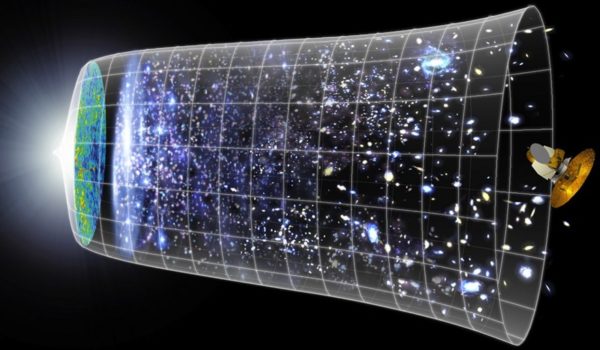 The fluctuations in the CMB give rise to the Universe's structure as it exists today. Image credit: NASA / WMAP Science Team.
The fluctuations in the CMB give rise to the Universe's structure as it exists today. Image credit: NASA / WMAP Science Team.
From PJ on the Expanding Universe: "One for Katie Mack !"
Katie made that statement tongue-in-cheek, but she also has a very legit and clear way of explaining what's actually observed to be going on with the expansion of the Universe:
The Universe might not have any borders at all. It might be infinite, or it might loop around on itself... we can't say with current data. What we can say is that the density of the Universe is going down with time, in the sense that the distances between distant things (galaxies, for instance) is getting larger. But that doesn't mean there's an edge beyond which there's some other kind of space. The Universe might be infinite and getting more infinite!
Mathematically, we describe spacetime as a coordinate system and then we add our (human) conceptions of putting down a grid, of that fabric stretching, etc. But all we can observe in the Universe is the stuff in it, not space itself, and that's what we see changing. That's, quite possibly, what's so difficult for all of us to wrap our heads around.
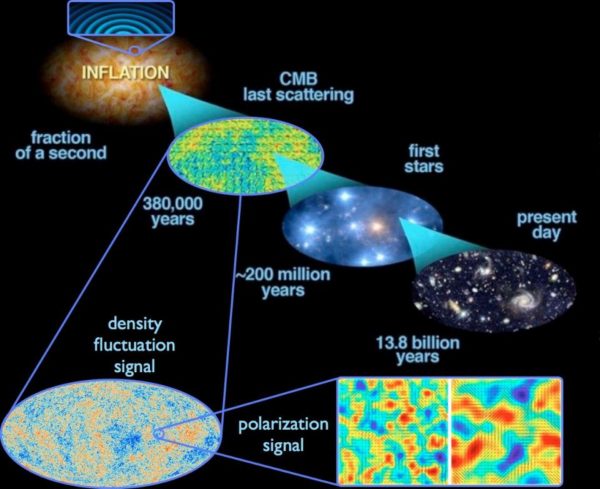 How cosmic inflation gave rise to our observable Universe, which has evolved into stars and galaxies and other complex structure by the present. Image credit: E. Siegel, with images derived from ESA/Planck and the DoE/NASA/ NSF interagency task force on CMB research. From his book, Beyond The Galaxy.
How cosmic inflation gave rise to our observable Universe, which has evolved into stars and galaxies and other complex structure by the present. Image credit: E. Siegel, with images derived from ESA/Planck and the DoE/NASA/ NSF interagency task force on CMB research. From his book, Beyond The Galaxy.
From John K. on the center of the Universe: "So, as it all expanded from a dimensionless point, then everything in the universe would be the original center, correct? That is, if you went to any point in the universe and played it backward to the Big Bang, you would find yourself at dead center at the Singularity. And playing it forward as it expanded and became less dense, everything else in the universe would seem to be rushing away from you at the center. Correct?"
Not a "dimensionless point," but rather a 3D region of space. There's a limit to how far back we can extrapolate, and that happens to be when what is now the observable Universe (46 billion light years in radius) was about the size of a soccer ball. Presumably, there was much more Universe than that, and everyone at every location we know of would be able to make that exact same extrapolation. Every observer would have equal claim to being at the center, although there would be no singularity to speak of.
Michael Kelsey added in a wonderful explanation: "If you run the simple (and now outmoded) classical model of general relativistic expansion from a singular point, you’re exactly right that _every_ current coordinate was originally superposed at that singularity (that’s one of the many mathematically ugly bits to being a singularity :-), and hence everywhere in the Universe has equal claim to being “the center.”
You are also correct that there’s no special “center point” anywhere in the Universe today. Anywhere you could stand, you see the expansion occurring away from you in all directions (after taking account of your local motion relatively to nearby stuff). So wherever you stand, you can make the observational claim that you’re at the center. And so can all those other observers elsewhere."
In other words, you are at the center from your point of view, but if you ask what other observers would see, you can gain a superior perspective and learn that there's no "true" center at all. Someday, perhaps, we'll be able to empirically confirm that by traveling to great distances. We can hope.
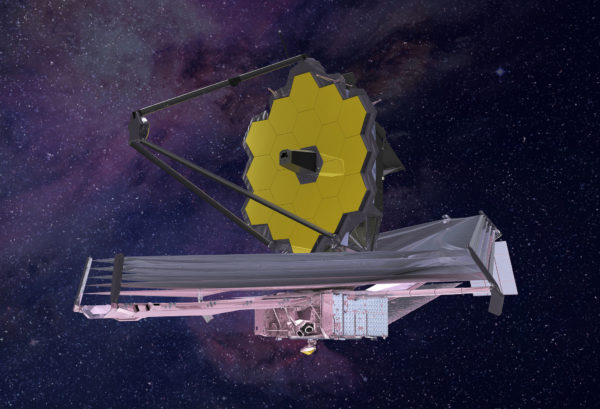 An artist's conception (2015) of what the James Webb Space Telescope will look like when complete and successfully deployed. Image credit: Northrop Grumman.
An artist's conception (2015) of what the James Webb Space Telescope will look like when complete and successfully deployed. Image credit: Northrop Grumman.
From PJ on what James Webb will reveal: "I somehow feel JWST is going to show us more of the same, younger galactic configurations. Eventually, we will have to learn what will be needed to view beyond the first moments of starlight."
Well the hope is that JWST will show us not only that, but will show us earlier configurations than we've ever seen before. Perhaps it will reveal large numbers of true Population III star clusters: pre-galaxies. Perhaps it will even reveal individual stars, forming for the first time. And most likely it's going to reveal better and more precise information about the earliest proto-galaxies that we can see.
If we want to go beyond starlight, though, to even earlier times, there is a way to do it: through 21-cm hydrogen lines. Keep in mind: that's 21-cm lines in our rest frame, and if we wanted to see them at a redshift of ~99, that suddenly becomes 21-meter lines. May our telescopes someday reveal them! Do I hear any candidates for a giant space telescope at radio frequencies?
The reionization and star-formation history of our Universe, where reionization was driven by these faint, early but theoretically numerous galaxies. At last, thanks to Livermore's work, we're discovering them. Image credit: NASA / S.G. Djorgovski & Digital Media Center / Caltech.
From eric on what a sci-tease I am: "Tease! I thought you were actually going to explain reionization (i.e. the theories and observations that came out of the technique) Oh well, maybe another post."
Well, I can give you the quick version:
- After recombination (when neutral atoms form and the CMB can free-stream), there is no radiation energetic enough to ionize any of the atoms, and the Universe is 100% neutral.
- When gravitational collapse occurs, the energy associated with gravitational potential and from atoms colliding gets partially converted into radiation, but it's not substantial enough to ionize any appreciable fraction of atoms.
- When the first stars form (in theory), they do so in isolation and in very small numbers, and don't emit enough UV (or more energetic) light to do much in the way of reionization.
- When large star clusters form, either through larger-scale collapse or mergers, this triggers large bursts of star formation, where the energies are larger than even the most massive star clusters formed today.
- It's thought that these large star clusters -- which one could rightly call the first galaxies (or proto-galaxies) -- are the dominant factor in contributing to reionization. It's the galaxies that cause the Universe to reionize.
Our measurements of optical depth support this picture; our quasar and distant-galaxy absorption features support it; our deep-field measurements of galaxies with Spitzer and Hubble support it. But we need better data to know for sure. Those are the best steps, as of Garth Illingsworth's talk at AAS about 6 weeks ago. (Aren't you glad I stay up on all of this?)
A model of Haumea rotating, based on the most accurate data available. Image credit: Wikimedia Commons user Stephanie Hoover.
From Denier on how one could obtain a flat planet: "You could start with a slow rotating, liquid covered planet that was tectonically inactive, and through gravitational interaction with another body kick it out of the solar system or into a higher orbit so that the liquid cover froze solid. Queball planet."
I don't know that I quite follow how this picture would work. If you had a slow-rotating, liquid covered planet, it would be nearly spherical. (That's due to the slow rotation.) If you kick it out to a higher orbit, that's fine; the surface liquid will freeze. Minus the "I used to have surface liquid" part, that's kind of similar to how we've observed Pluto to be.
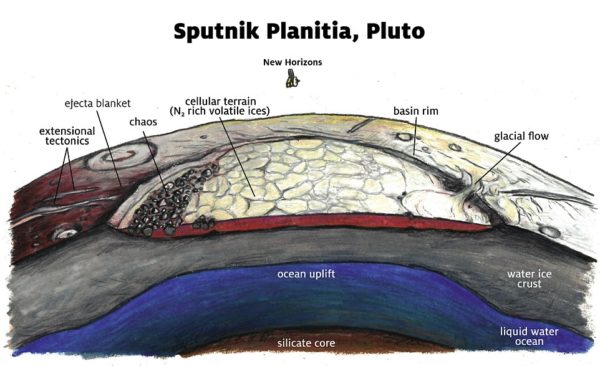 The geological features and scientific data observed and taken by New Horizons indicate a subsurface ocean beneath Pluto’s surface, encircling the entire planet. Illustration credit: James Keane.
The geological features and scientific data observed and taken by New Horizons indicate a subsurface ocean beneath Pluto’s surface, encircling the entire planet. Illustration credit: James Keane.
The question I have is: how would that flatten the world at all? If you're in hydrostatic equilibrium, then the only way to flatten your world is by spinning faster. Any "freezing" of the ice wouldn't be strong enough to hold up against the combination of gravity and angular momentum; the ice would break and re-freeze in a new, better configuration. This is true of rock and metal as well; it isn't just ice!
The other scenario you threw out wouldn't work, either. If you're not in hydrostatic equilibrium (via uneven, substantial erosion, for instance) then you don't have enough gravity/mass to be a planet.
Naval soldiers prepare to fire a gun salute during a burial at sea. This would be catastrophically unsafe in any region where the bullets could come down and land on a human. Image credit: U.S. Navy photo by Mass Communication Specialist 3rd Class Kevin J. Steinberg.
From Bob on firing guns into the air: "My friends cousin was kill on News Years Eve in New Orleans by a bullet someone fired into the air. She and friends were eating at an outside cafe. when she suddenly collasped. . That’s when they saw the bullet hole in the top of her head. Twenty one years old"
That is just tragic. Most urban areas have laws against doing this, but the penalty is usually something like a $1,000 fine. Surely someone's life is worth more than that.
From Denier on guns vs. firecrackers: "Firecrackers are banned in many places in the US. They’re dangerous don’t you know."
When I was 12 years old, I knew this guy, maybe a year older than me, named Todd. Todd used to light a firecracker, hold it, hold it, hold it, and then at the very last second, throw it into the air and try to get it to explode as high up as possible. He would frequently dare me to do the same thing, and I never did.
To the best of my knowledge, Todd still has all his fingers, but I don't regret not playing that game.
From Omega Centauri on potentially habitable super-Earths: "So to lose its H2,He and now be in the habitable zone a “super earth” would have to have had an unusual history. Either it would have had to migrate outwards after it lost its atmosphere, like in the grand tack models for Jupiter, or perhaps it could it have lost its atmosphere due to an exceptionally violent collision?"
Now, this is interesting. Rather than look at most planets in this class and determine their suitability for habitability, you want to look at the corner cases, and ask, pretty much, "what would it take for a super-Earth to be habitable like Earth is, and how likely is that to occur?"
You'd need to strip off the H/He envelope early, and most of the rest of a "puffy" atmosphere as well. You'd need to strip the world down to only a thin atmosphere, but not beyond that. And then you'd need to have a planetary migration outwards occur, away from the star and out towards a more temperate zone. Certainly, this is possible, and pointing to the possibility of planetary migration in our own Solar System is a good example. You'd also want a star that was G-class or more massive, for the ultraviolet radiation providing a necessary "kick" to the atmospheric particles, but not too much more massive so that the lifetime of the star/planetary system was too short.
I'd venture to say that even if this is a 1-in-1,000 or even a 1-in-1,000,000 occurrence, we'll have plenty of examples in our own galaxy where this occurs. Perhaps someday our exoplanetary measurements and sample sizes will grow so large that we'll find one, and perhaps that will occur even in our lifetimes. Perhaps we'll even learn what the probability of this occurrence is, empirically. That's a pretty incredible thought!
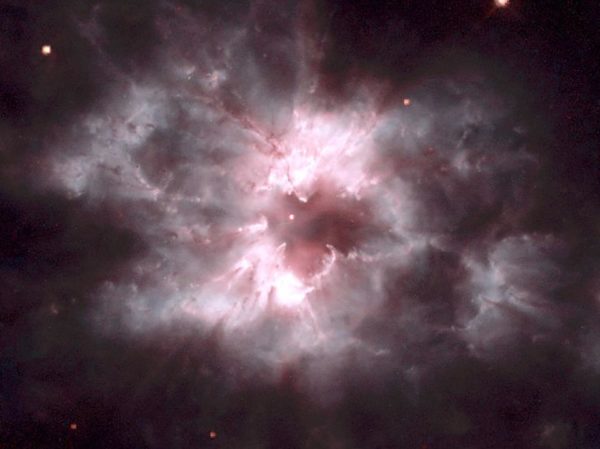 At the end of their lives, massive stars eject their outer layers back into the interstellar medium, enriching the Universe with elements beyond hydrogen and helium. Image credit: H. Bond (STScI), R. Ciardullo (PSU), WFPC2, HST, NASA.
At the end of their lives, massive stars eject their outer layers back into the interstellar medium, enriching the Universe with elements beyond hydrogen and helium. Image credit: H. Bond (STScI), R. Ciardullo (PSU), WFPC2, HST, NASA.
And finally, from John on the things we can agree on: "The Universe is a violent and constantly changing place."
This is true, but what's most remarkable is how this is true. We can quantify the violence -- the radiation pressure, the ionization, the stellar death, the winds and outflows -- and we can quantify the changes on all scales. It's not just that the Universe is changing, but that we can determine how it changes at a variety of stages all along the way. Our Universe began as a sea of matter-and-antimatter-and-radiation, with no stable atoms or atomic nuclei. It formed a matter/antimatter asymmetry; it formed hydrogen and helium nuclei; it formed neutral atoms; it formed stars, star cluster, proto-galaxies, galaxies, groups and clusters; it formed heavier elements, rocky planets, organic molecules and life. And we're learning more about it with every measurement, observation and experiment we perform.
It's a good time to be alive. Hope you enjoy it, and I'll see you back here in the very near future for more Starts With A Bang!
- Log in to post comments

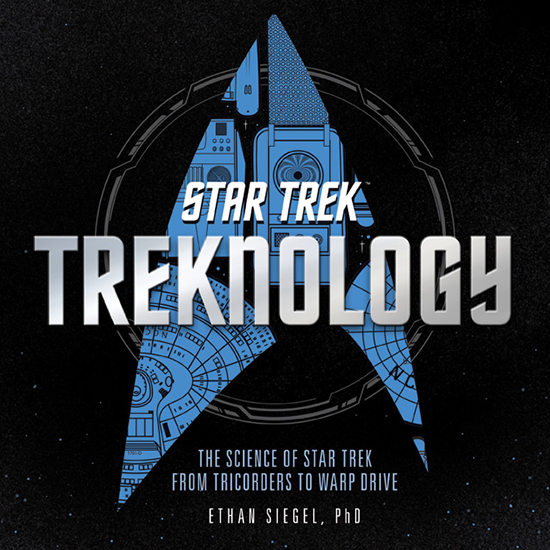
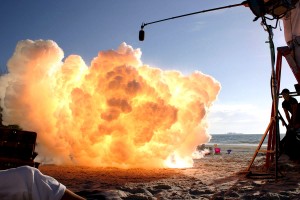
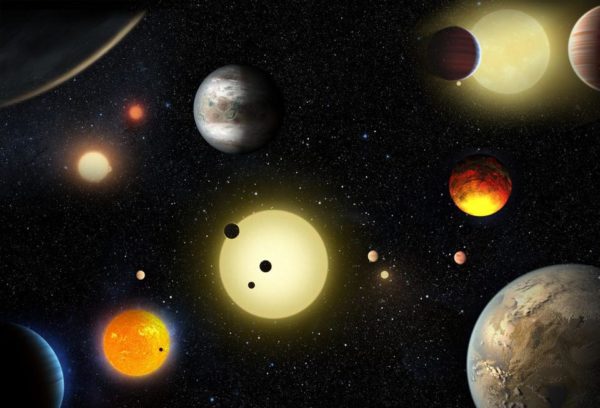
Ethan,
Thank you.
I do have a request for a future article. As is often the case in matters Scientific, the answer to one question, the solar neutrino problem, gives rise (at least in my mind) to another.
The phenomenon of neutrino oscillation implies neutrinos have a non-zero mass. Taking this as given, the speed of neutrinos should be slightly lower than the speed of light.
Is there any measurement showing, within the experiment’s margin of error, that neutrinos do travel slower than the speed of light? As a follow on question, where does the mass come from? When I learned of this particle, it was defined as having no mass.
Anyway, the neutrino mass seems to be under-reported, so I thought I'd ask.
Yeah, don't buy his bullshit. He's a religious fundamentalist trying to hide it so he can pretend to know science while he makes asinine claims about it.
He's just BSing. Again.
@ John
this might be a good summary on the current experimental efforts
https://www.youtube.com/watch?v=lDZRrt_v-Es
"Anyway, the neutrino mass seems to be under-reported, so I thought I’d ask...."
Mmmm.. how so? Perhaps if you're not in the field of science or general news you might get that impression. But since Nobel prize in physics in 2015 was awarded for neutrino research and findings, you can't get more reporting than that.. and it was covered everywhere.
@Ethan wrote:
Has anyone told you you're not very good at conceding points? As for feeding you lies, that isn't just me. It is also Thurgood Marshall. You know, that person you "studied".
The Fairness Doctrine won't work because it relied on FCC licences of spectrum. MPAA ratings are voluntary. Food labels and album warning stickers have to do with regulating commerce.
@Ethan wrote:
As I've already answered this exact question several weeks ago, we're now just rehashing the same ground and I think this a good place to move on.
" As for feeding you lies, that isn’t just me."
No, that was you. Thurgood hasn't posted to SWAB.
John @1:
Yes, several. There's even a Wikipedia page titled "Measurements of neutrino speed" which gives an overview of them.
Wow, denier is still lying about Ethan's position but thinks it is a good time to move on. Talk about being bad at conceding points.
Nah, thanks for that advice, but I decline.
Not demanding you put yourself out, or that anyone deciding to either never join in, or to get out when it seems like it is pointless are wrong, but that's their decision, not mine.
Ta.
reic @7
The Wikipedia entry I read "Measurements of neutrino speed" contained entries indicating that within the margin of error this is consistent with no deviation from C at all, or 90%, or consistent with the speed of light, etc.
The OPERA experiment was an outlier.
The only one talking about OPERA is you in that post, teabaggie.
If you want help here you have to be a lot clearer about what you mean and if you meant to ask about the OPERA results, have contained that in your original query.
Doing otherwise is just wasting the time and effort of others here, and pollutes the thread with needless dancing around what you said and what you later claim, only to dance on to further unexpencted and untelegraphed claims.
@ John
several of the test for general relativity couldn't be experimentally measured for several decades due to lack of sensitivity in equipment and tech in general. Given that we became aware of neutrinos having ANY mass just few years ago and that mass is so tiny and thus it's speed so close to c (to a few decimal places)... it's gonna be a while till experiments become sensitive enough to get that directly and noise down.
Sinisa Lazarek @ 12
Those points too could be part of what I am looking for.
@Ethan wrote:
Viscous relaxation. Ice covered Galilean satellites have surfaces with very low topographic relief. Essentially the craters are filling themselves in. It is the same phenomenon responsible for the flow of glaciers here on Earth.
Pluto is a poor analog as it is geologically diverse with a subsurface ocean that acts as an upper mantle facilitating volcanoes and tectonics. Queball planet would have a uniform icy crust and far enough away from any other sizable bodies so that it isn't subjected to tidal heating. Then just let viscous relaxation, wind erosion, and time do their thing.
@ Denier
sounds to me that you and Ethan are talking about different things. In your scenario.. the surface would be flattened.. but the overall planet would still be spherical like Ethan wrote. Ethan's scenario talks about the whole sphere flattening. A small crust of ice can't flatten rock core underneath. I think that's what Ethan is pointing out in this case.
@Denier,
I agree with SL. As far as I can tell, Ethan isn't exploring the idea of how to make a sphere really really smooth on the surface, he's exploring the idea of just how much you can deform a planet into a pancake shape before it breaks.
OK. I get it. 2D flat, not 3D flat.